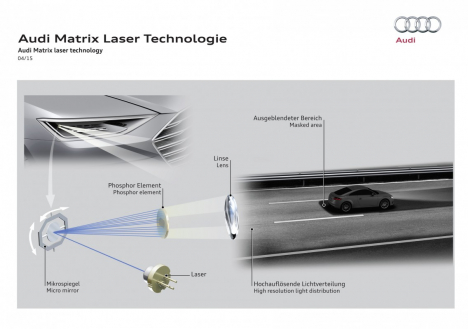Matrix Laser technology
Audi is further extending its lead in automotive lighting technology. In the sponsored project “intelligent laser light for compact and high-resolution adaptive headlights” (iLaS), the brand with the four rings is working on the headlights of the future with partners from industry and science. Matrix Laser technology and its high resolution will make roadway illumination even more flexible and highly versatile – in all situations.
Matrix Laser technology is based on the LaserSpot for high‑beam lamps, which Audi first introduced to production in the Audi R8 LMX. For the first time, bright lasers are making it possible to integrate projector technology in a compact and powerful headlight.
The new technology operates with a rapidly moving micro-mirror, which redirects the laser beam. At low vehicle speeds, the light is distributed to a larger projection area, and the road is illuminated with a very wide range. At high speeds, the aperture angle is smaller, and the intensity and range of the light are increased significantly. This is especially advantageous in highway driving. In addition, the light can be distributed precisely. This means that the brightness of different lighting zones can be varied by controlling the illumination dwell times in the specific zones.
Also new is intelligent and lightning-fast activation and deactivation of the laser diodes in relation to the mirror position. This makes the broadening or narrowing of the luminous beam dynamic and highly variable. As with today’s Matrix LED headlights from Audi, the road is always brightly lit without causing glare to other participants in traffic. The crucial difference is that Matrix Laser technology offers even finer dynamic resolution and therefore a higher degree of utilization, which leads to greater safety in road traffic.
In the new technology, blue laser diodes from OSRAM radiate their light, which has a wavelength of 450 nanometers, onto a quickly moving mirror that is three millimeters in size. This mirror redirects the blue laser light to a converter, which converts it to white light and projects it onto the road. The mirror used for this, which comes from the Bosch company, is a micro-optical system that features electro-mechanical control and is based on silicon technology. It is very sturdy and exhibits very long life. Such components are also used for accelerometers and control units for electronic stability control.
For many years now, Audi has been the leader in automotive lighting technology. Some of the brand’s key innovations:
2003: Audi A8 with adaptive light
2004: Audi A8 W12 with LED daytime running lights
2008: Audi R8 with all‑LED headlights
2010: Audi A8 in which the headlights are networked with the navigation data
2012: Audi R8 with dynamic turn signal lights
2013: Audi A8 with Matrix LED headlights
2014: Audi R8 LMX with LaserSpot for the high‑beam lamps
In the framework of the three-year “iLaS” project, Audi is working closely with its partners Bosch, Osram and the Lichttechnischen Institut (LTI; “Lighting Technology Institute”) of the Karlsruhe Institute for Technology (KIT). The project is sponsored by the German Federal Ministry for Education and Research.
Status: 4/2015
